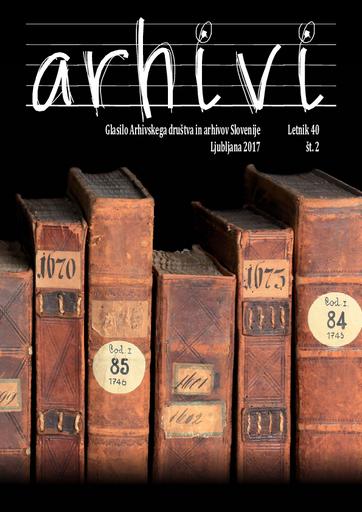/
Serijske publikacije
/
Arhivi
Redovne province na Slovenskem kot povezovalke prostorov od konca 16. stoletja do Jožefa II.


To delo avtorja Lilijana Žnidaršič Golec je ponujeno pod Creative Commons Priznanje avtorstva-Nekomercialno-Deljenje pod enakimi pogoji 4.0 Mednarodna
Datoteke (1)

Opis
Prispevek usmerja pogled v tiste redove in samostane na Slovenskem, ki so oblikovali oziroma sestavljali redovne province v obdobju od konca 16. stoletja do začetka osemdesetih let 18. stoletja. V ospredju so vprašanja o provincijskih mejah in njihovih spremembah ter povezavah med samostani na provincijski ravni. Izpostavljeni so geografska razsežnost provinc, politično ozadje spreminjanja provincijskih ozemelj glede na deželne oziroma državne meje, vzgojno-izobraževalne vezi v provincah frančiškanov, kapucinov in jezuitov, pa tudi večetničnost in večjezičnost posameznih provinc in redovnih skupnosti. Ob nekaj zgledih razprava posebej opozarja na povezovalno vlogo provinc na področjih verske pobožnosti in upodabljajoče umetnosti.
Metapodatki (12)
- identifikatorhttps://hdl.handle.net/11686/41527
- naslov
- Redovne province na Slovenskem kot povezovalke prostorov od konca 16. stoletja do Jožefa II.
- Creating Territorial and other Connections. The Orders’ Provinces in Slovenia from the End of the 16th to the Late 18th Centuries
- avtor
- Lilijana Žnidaršič Golec
- soavtor
- Gregor Jenuš (gl. in odg. ur.)
- Dunja Mušič (teh. ur.)
- Petra Markuš (prev.)
- Tanja Martelanc (foto.)
- predmet
- ČLANKI IN RAZPRAVE
- redovi
- redovne province
- samostani
- Slovenija
- zgodnji novi vek
- ARTICLES AND PAPERS
- religious orders
- orders' provinces
- religious communities
- Slovenia
- Early Modern Times
- territorial connections
- opis
- In early modern Europe, the orders’ provinces—territorial units comprising several communities of individual religious orders—covered areas that were part of different political entities. The paper focuses on the monasteries and convents operating in the Slovenian (ethnic) territory between the end of the 16th century and the beginning of the independent reign of Joseph II in 1780. The main attention is paid to the predominantly large provincial territories the communities of individual orders belonged to. During the period in question, provincial affiliation underwent several changes, in most cases according to the aspiration of the territorial duke to align ecclesiastical (provincial, diocesan etc.) and political (state) boundaries. In 1609, under Ferdinand II, the convent of the Capuchin friars in Gorizia was transferred from the »foreign« Venetian province to the »home« province of Styria, and in 1653, Ferdinand III decreed that the Augustine Hermits’ monasteries of the Styrian-Carinthian province join the ones in the Austrian province. Under Leopold I, the monasteries of the Conventual Franciscans (Minorites) in Gorizia, Trieste, and Grignano near Trieste became part of the Styrian-Carinthian province (1668), while the Dominican convents in Ptuj and Novi Klošter became part of the HungarianAustrian province (1702). After 1702, the newly established Austrian province encompassed all the communities of Discalced Carmelite friars in the Austrian hereditary lands, including the community at Kostanjevica near Gorizia. In 1769, Maria Theresa ordered the incorporation of the Servite convents in Duino and Gradisca d’Isonzo into the province of Tyrol. Similar steps were taken by the authorities of the Republic of Venice, on the territory of which were located the monasteries in Koper, Izola, and Piran. Beside territorial dimensions, the ethnic and linguistic aspects are pointed out at the provincial and the individual community levels. Multi-ethnicity and multilingualism, characteristic of earlier periods, began to be considered an obstacle. In the Franciscan, Capuchin, and Jesuit provinces an important unifying role was played by the formation system with relocations of places housing religious novices and the philosophical and theological studies as well as by frequent relocations of their members. The suppression of the Jesuit order in 1773 and the Josephine dissolutions in 1782–1787 not only impoverished the religious »landscape«, but also severed many a tie in various fields, such as music, architecture and fine arts.
- založnik
- Arhivsko društvo Slovenije
- datum
- 2017
- 01. 01. 2017
- tip
- besedilo
- jezik
- Slovenščina
- jeDelOd
- pravice
- licenca: ccByNcSa
